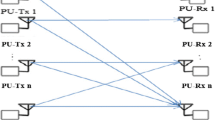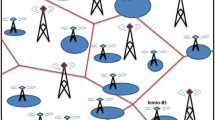Abstract
In dynamically changing environments, the spectrum-sharing method is a promising method to address the spectrum underutilization problem for cognitive radio (CR) systems. This paper investigates the capacity of cognitive radio multiple-access channel (CR-MAC) over a dynamic fading environment. Multiple secondary users (SUs) transmit to the secondary base station under the transmit power (TP) and interference temperature (IT) at the primary base station constraints. In order to perform a general analysis, a theoretical dynamic fading model termed hyper-fading model, which is suitable to the dynamic nature of cognitive radio channel, is considered. The optimal power allocation method is employed to maximize the capacity of CR-MAC for hyper-fading channel with TP and IT constraints and full channel side information. Through the numerical simulations, the capacity of the hyper-fading channels are compared with that of other channel fading models such as Rayleigh, Nakagami-2, and with an additive white Gaussian noise channel. Additionally, the impacts of the number of SUs on capacity is investigated.
Similar content being viewed by others
References
Mitola J. III, Maguire G. Q. Jr. (1999) Cognitive radio: Making software radios more personal. IEEE Personal Communications 6(4): 13–18
Ekin, S., Yilmaz, F., Celebi, H., Qaraqe, K. A., Alouini, M.-S., & Serpedin, E. (2009). Achievable capacity of a spectrum sharing system over hyper fading channels. In IEEE global communications conference (GLOBECOM), Honolulu, HI, 30 Nov–4 Dec 2009.
Facilitating opportunities for flexible, efficient, and reliable spectrum use employing cognitive radio technologies. Federal Communications Commission (FCC), Technical report ET Docket no. 03-108, Mar 2005.
Cognitive radio technology—a study for ofcom. http://www.ofcom.org.uk/research.
Weiss T. A., Jondral F. K. (2004) Spectrum pooling: An innovative strategy for the enhancement of spectrum efficiency. IEEE Communications Magazine 42(3): 8–14
Akyildiz I. F., Lee W. Y., Vuran M. C., Mohanty S. (2006) Next generation/dynamic spectrum access/cognitive radio wireless networks: A survey. Computer Networks 50(13): 2127–2159
Haykin S. (2005) Cognitive radio: Brain-empowered wireless communications. IEEE Journal on Selected Areas in Communications 23(2): 201–220
Ghasemi A., Sousa E. (2007) Fundamental limits of spectrum-sharing in fading environments. IEEE Transactions on Wireless Communications 6(2): 649–658
Zhang R., Cui S., Liang Y.-C. (2009) On ergodic sum capacity of fading cognitive multiple-access and broadcast channels. IEEE Transactions on Information Theory 55(11): 5161–5178
Ji, J., Chen, W., Wan, H., & Liu, Y. (2010). Capacity analysis of multicast network in spectrum sharing systems. In IEEE international conference on communications (ICC), 2010 (pp. 1–5). IEEE.
Suraweera H., Smith P., Shafi M. (2010) Capacity limits and performance analysis of cognitive radio with imperfect channel knowledge. IEEE Transactions on Vehicular Technology 59(4): 1811–1822
Kolodzy P. (2006) Interference temperature: A metric for dynamic spectrum utilization. International Journal of Network Management 16(2): 103–113
Gastpar, M. (2004). On capacity under received-signal constraints. In Proceedings of the 42nd annual allerton conference on communication, control and computing.
Yang L., Alouini M. (2006) Performance analysis of multiuser selection diversity. IEEE Transactions on Vehicular Technology 55(6): 1848–1861
Yang L., Kang M., Alouini M. (2007) On the capacity-fairness tradeoff in multiuser diversity systems. IEEE Transactions on Vehicular Technology 56(4 Part 1): 1901–1907
Ban T. W., Choi W., Jung B. C., Sung D. K. (2009) Multi-user diversity in a spectrum sharing system. IEEE Transactions on Wireless Communications 8(1): 102–106
Ban T. W., Choi W., Sung D. K. (2009) Capacity and energy efficiency of multi-user spectrum sharing systems with opportunistic scheduling. IEEE Transactions on Wireless Communications 8(6): 2836–2841
Simon M., Alouini M. (2004) Digital communication over fading channels (2nd ed.). Wiley-Interscience, New York
Abdi A., Lau W., Alouini M., Kaveh M. (2003) A new simple model for land mobile satellite channels: First-and second-order statistics. IEEE Transactions on Wireless Communications 2(3): 519–528
Alouini M., Goldsmith A. (2000) Adaptive modulation over Nakagami fading channels. Springer, Wireless Personal Communications 13(1): 119–143
Boyd S., Vandenberghe L. (2004) Convex optimization. Cambridge University Press, Cambridge
Kang X., Liang Y., Nallanathan A., Garg H., Zhang R. (2009) Optimal power allocation for fading channels in cognitive radio networks: Ergodic capacity and outage capacity. IEEE Transactions on Wireless Communications 8(2): 940–950
Author information
Authors and Affiliations
Corresponding author
Rights and permissions
About this article
Cite this article
Qaraqe, K.A., Ekin, S., Agarwal, T. et al. Performance Analysis of Cognitive Radio Multiple-Access Channels Over Dynamic Fading Environments. Wireless Pers Commun 68, 1031–1045 (2013). https://doi.org/10.1007/s11277-011-0497-y
Published:
Issue Date:
DOI: https://doi.org/10.1007/s11277-011-0497-y




